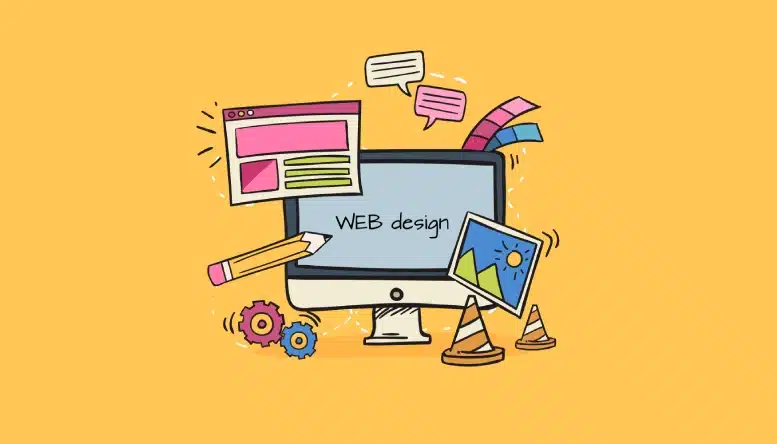Creative Internet Layout Solutions for Modern and Engaging Websites
In the realm of web design, the search of modern-day and interesting options has actually ended up being increasingly vital for businesses intending to record individual interest. By integrating bold shade plans, interactive aspects, and responsive formats, developers can produce experiences that not only reverberate with individuals however also boost brand name identity.
Embracing Vibrant Color Pattern
In internet style, the strategic use strong color design can substantially improve customer interaction and brand identity. By utilizing dynamic tones, developers can create aesthetically striking sites that capture interest and foster a remarkable experience. An appropriate color scheme not only mirrors a business's worths however also stimulates specific feelings that can influence customer behavior.
Vibrant colors can be used to direct customers' interest to crucial elements such as contact us to activity, enhancing conversion prices. Using contrasting shades for switches and links can make these aspects stand out, motivating users to engage even more readily. In addition, a cohesive color system throughout the site strengthens brand name acknowledgment, creating a sense of experience and trust fund among visitors.
However, it is critical to balance bold colors with sufficient white area to stay clear of frustrating customers. Reliable use typography also complements bold colors, making sure readability while maintaining visual allure. Inevitably, embracing bold color schemes in web design not only elevates visual top quality yet additionally plays an integral role in achieving tactical company objectives, making it a vital consideration for contemporary web development.

Utilizing Interactive Aspects
Interactive elements are necessary in modern website design, as they substantially boost user interaction and create a much more vibrant browsing experience. By including features such as animations, float effects, and clickable aspects, websites can motivate customers to explore material more completely and return for future brows through.

Micro-interactions, such as refined animations when a button is clicked or a kind is sent, can also enhance the customer experience by supplying instant feedback. These tiny details can make the site really feel even more responsive and active, promoting a sense of link between users and the website.
Moreover, gamification elements, such as benefits for completing certain activities, can motivate customers to engage with the material more deeply. By thoughtfully incorporating these interactive components, internet designers can produce a remarkable and engaging on-line experience that reverberates with individuals and urges them to return.
Implementing Receptive Layout
Executing responsive layout hop over to here is essential in today's multi-device landscape, making sure that websites offer an ideal watching experience across various screen dimensions. As customers increasingly access the internet with smart devices, tablet computers, and desktops, a one-size-fits-all method is no more sensible. Responsive design enables for seamless navigation and communication, adjusting format and web content to fit the tool being used.
Secret principles of receptive layout consist of fluid grids, flexible images, and media questions. Media questions assist in the application of different styles based on the tool's features, such as size, height, or resolution, permitting developers to tailor the user experience effectively.
In addition, receptive design boosts search engine optimization performance, as online search engine favor mobile-friendly websites. By executing responsive layout, companies not only boost individual satisfaction and involvement however also raise their reach in a competitive digital landscape. As innovation remains to advance, embracing receptive style has ended up being a fundamental technique for any type of you could try these out modern and appealing website.
Incorporating Multimedia Content
Multimedia web content plays an important duty in creating interesting and dynamic internet experiences that capture individuals' focus and enhance understanding. By incorporating text, pictures, sound, and video, web sites can offer a richer story that interest different finding out styles and preferences. This assimilation not only reinforces customer engagement however additionally aids in communicating intricate ideas succinctly.
Incorporating high-grade pictures and infographics can separate textual web content, making it much more absorbable. In a similar way, video tutorials and presentations can supply comprehensive insights that static material might not totally interact. Audio aspects, such as podcasts or history songs, can also enhance the environment of a web site, developing a more immersive experience.
Furthermore, the calculated use multimedia can boost search engine optimization efficiency, as search engines favor diverse content types, increasing visibility. Nevertheless, it is important to make sure that multimedia aspects do not impede page tons times, as this can result in user disappointment. By balancing multimedia integration with efficiency factors to consider, internet designers can create visually attractive and practical sites that resonate with customers, cultivating a much deeper connection and encouraging return visits.
Focusing On Individual Experience

To attain an optimal user experience, designers should concentrate on numerous crucial concepts. Initially, responsive design is essential; web sites need to adjust seamlessly to various devices and screen dimensions. This ease of access guarantees that individuals can engage with content regardless of their chosen system. Clearness in design and pecking order is important. Clear phone call to action, legible typography, and arranged material guide users, reducing cognitive lots.
Ultimately, prioritizing UX not just elevates individual satisfaction however additionally drives engagement and conversion rates, making it a critical aspect of modern-day web design methods. By placing users at the facility of layout efforts, sites can produce long-term, positive perceptions that urge return visits.
Final Thought
In verdict, modern web style options that stress bold color pattern, interactive aspects, receptive layout, and multimedia content considerably improve customer involvement and satisfaction. Prioritizing individual experience with clear formats and continual responses further adds to improved conversion rates. By adopting these techniques, sites can efficiently mesmerize visitors and strengthen brand identity, eventually resulting in a much more dynamic and engaging image source online presence. The integration of these design concepts is crucial for attaining modern-day internet style goals.